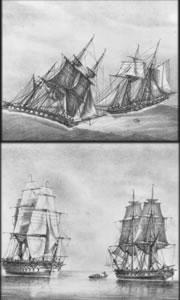“We have caught physicists in the very act of creating a myth.”
Fabrizio Pinto
Some stories are just too good to be true. And according to physicist Fabrizio Pinto, that's exactly the case for an analogy routinely used by physicists to illustrate the mysterious Casimir effect.
The Casimir effect is a strange force of attraction seen between two surfaces separated by empty space. And it has become almost obligatory for popular articles on the subject to mention that the same effect also operates between ships lying close together in a strong swell.
This notion stems from an article published in 1996 by Dutch scientist Sipko Boersma1. He pointed out that the French nautical writer P. C. Caussée stated in his 1836 book The Album of the Mariner that two ships should not be moored too close together because they are attracted one towards the other by a certain force of attraction. Boersma suggested that this early observation could be described by a phenomenon analogous to the Casimir effect.
Just popping out
The Casimir force arises from the way that empty space is pervaded by 'vacuum fluctuations' — electromagnetic waves created by 'virtual' particles that pop briefly in and out of existence. In infinite space these waves can have any wavelength. But in a confined space, like that between two parallel plates, the wavelengths cannot exceed the maximum width of the space. This reduction in vacuum fluctuations acts rather like a reduction in pressure: it means that the plates get pushed together.
The effect that Hendrik Casimir proposed in 1948 is now well established experimentally, and although it is very weak at the everyday scale, it can cause very small objects to stick together.
Boersma suggested that if ships moor in a large swell, waves with wavelengths longer than the distance between the ships would be suppressed in the space separating them. This could perhaps pull the ships together.
Spot the difference
 The pictures in Caussée’s book refer to ships moored in windless but rolling seas (top: ‘Calme avec grosse houle’) and in a flat calm (bottom: ‘Le calme plat’). Click here to read the original captions in French: only the second refers to “une certaine force attractive”.
The pictures in Caussée’s book refer to ships moored in windless but rolling seas (top: ‘Calme avec grosse houle’) and in a flat calm (bottom: ‘Le calme plat’). Click here to read the original captions in French: only the second refers to “une certaine force attractive”.It is a lovely story, and has been much repeated, including in Nature2. But Pinto has told news@nature.com that it is based on a mix-up.
Pinto had two reasons to be curious about the naval story. A former NASA scientist, he is both a keen sailor and president of InterStellar Technologies, a company that researches practical applications of the Casimir force. So he searched out a copy of Caussée's book to find out more about it.
To his surprise, Pinto found that Caussée never claimed that two ships attract in a heavy swell. Rather, he said that this happens when the sea is completely calm.
Caussée included two elegant prints in his book. One showed ships tossed about on a high swell, to illustrate the potential problem of their masts getting tangled if they are moored too close together. The other showed two ships in flat seas, and a small rowing boat pulling them apart to counter a mysterious attractive force. Boersma included the high-swell picture in his paper, writing: "The old tales were true. Rolling ships do attract each other." But this has mixed the two situations up, says Pinto.
"Physicists just fell in love with the theory," says Pinto. And it seems no one ever checked it out.
When asked about the mix-up, Boersma emailed news@nature.com saying that the problem lies with an "editing error" in the original Caussée book, and standing by the physics in his 1996 paper.
Parallel parking
So do ships attract each other at all, whether in a high swell or calm? Pinto says he hasn't found any real evidence for the effect, in either sailing or scientific literature.
Naval architect Jason Smithwick of Southampton University says he has never heard of such an effect. "I could imagine how it might possibly happen, but it would take a very specific set of circumstances," he told news@nature.com. "It's nothing that naval architects have ever worried about."
ADVERTISEMENT
Pinto thinks that the whole tale is symptomatic of physicists' approach to the history of their subject. "Physicists love lore about their own science," he says. "There are other stories that are unfounded historically." (See 'Lore makers'.)
Once established, Pinto says, these myths are accorded such reverence that questioning them seems almost an act of heresy, and 'whistleblowers' get a very hostile reception. The best plan, then, is to squash the myths before they take root. Here, he suggests, "we have caught physicists in the very act of creating a myth."
Visit our physicsmythisall_at.html">newsblog to read and post comments about this story.
